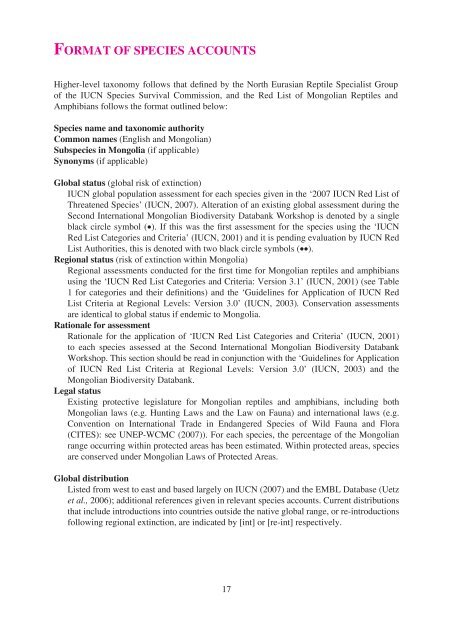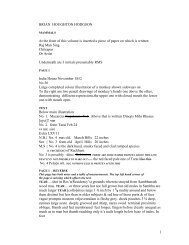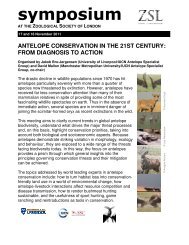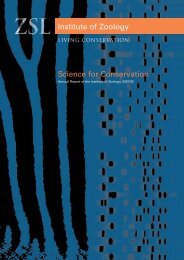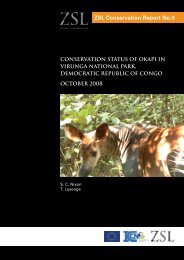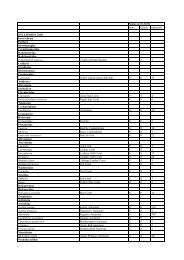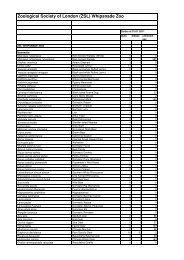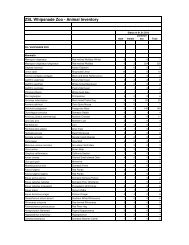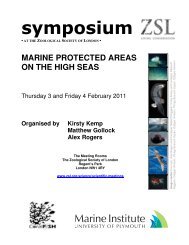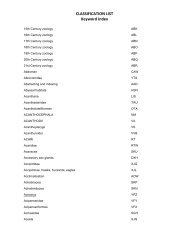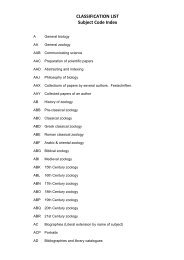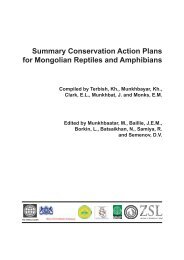Mongolian Red List of Reptiles and Amphibians - Web - Zoological ...
Mongolian Red List of Reptiles and Amphibians - Web - Zoological ...
Mongolian Red List of Reptiles and Amphibians - Web - Zoological ...
You also want an ePaper? Increase the reach of your titles
YUMPU automatically turns print PDFs into web optimized ePapers that Google loves.
FORMAT OF SPECIES ACCOUNTS<br />
Higher-level taxonomy follows that defi ned by the North Eurasian Reptile Specialist Group<br />
<strong>of</strong> the IUCN Species Survival Commission, <strong>and</strong> the <strong>Red</strong> <strong>List</strong> <strong>of</strong> <strong>Mongolian</strong> <strong>Reptiles</strong> <strong>and</strong><br />
<strong>Amphibians</strong> follows the format outlined below:<br />
Species name <strong>and</strong> taxonomic authority<br />
Common names (English <strong>and</strong> <strong>Mongolian</strong>)<br />
Subspecies in Mongolia (if applicable)<br />
Synonyms (if applicable)<br />
Global status (global risk <strong>of</strong> extinction)<br />
IUCN global population assessment for each species given in the ‘2007 IUCN <strong>Red</strong> <strong>List</strong> <strong>of</strong><br />
Threatened Species’ (IUCN, 2007). Alteration <strong>of</strong> an existing global assessment during the<br />
Second International <strong>Mongolian</strong> Biodiversity Databank Workshop is denoted by a single<br />
black circle symbol (•). If this was the fi rst assessment for the species using the ‘IUCN<br />
<strong>Red</strong> <strong>List</strong> Categories <strong>and</strong> Criteria’ (IUCN, 2001) <strong>and</strong> it is pending evaluation by IUCN <strong>Red</strong><br />
<strong>List</strong> Authorities, this is denoted with two black circle symbols (••).<br />
Regional status (risk <strong>of</strong> extinction within Mongolia)<br />
Regional assessments conducted for the fi rst time for <strong>Mongolian</strong> reptiles <strong>and</strong> amphibians<br />
using the ‘IUCN <strong>Red</strong> <strong>List</strong> Categories <strong>and</strong> Criteria: Version 3.1’ (IUCN, 2001) (see Table<br />
1 for categories <strong>and</strong> their defi nitions) <strong>and</strong> the ‘Guidelines for Application <strong>of</strong> IUCN <strong>Red</strong><br />
<strong>List</strong> Criteria at Regional Levels: Version 3.0’ (IUCN, 2003). Conservation assessments<br />
are identical to global status if endemic to Mongolia.<br />
Rationale for assessment<br />
Rationale for the application <strong>of</strong> ‘IUCN <strong>Red</strong> <strong>List</strong> Categories <strong>and</strong> Criteria’ (IUCN, 2001)<br />
to each species assessed at the Second International <strong>Mongolian</strong> Biodiversity Databank<br />
Workshop. This section should be read in conjunction with the ‘Guidelines for Application<br />
<strong>of</strong> IUCN <strong>Red</strong> <strong>List</strong> Criteria at Regional Levels: Version 3.0’ (IUCN, 2003) <strong>and</strong> the<br />
<strong>Mongolian</strong> Biodiversity Databank.<br />
Legal status<br />
Existing protective legislature for <strong>Mongolian</strong> reptiles <strong>and</strong> amphibians, including both<br />
<strong>Mongolian</strong> laws (e.g. Hunting Laws <strong>and</strong> the Law on Fauna) <strong>and</strong> international laws (e.g.<br />
Convention on International Trade in Endangered Species <strong>of</strong> Wild Fauna <strong>and</strong> Flora<br />
(CITES): see UNEP-WCMC (2007)). For each species, the percentage <strong>of</strong> the <strong>Mongolian</strong><br />
range occurring within protected areas has been estimated. Within protected areas, species<br />
are conserved under <strong>Mongolian</strong> Laws <strong>of</strong> Protected Areas.<br />
Global distribution<br />
<strong>List</strong>ed from west to east <strong>and</strong> based largely on IUCN (2007) <strong>and</strong> the EMBL Database (Uetz<br />
et al., 2006); additional references given in relevant species accounts. Current distributions<br />
that include introductions into countries outside the native global range, or re-introductions<br />
following regional extinction, are indicated by [int] or [re-int] respectively.<br />
17


